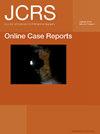Unilateral endophthalmitis after immediate sequential bilateral cataract surgery in a cognitively impaired patient: diagnosis and treatment
Q4 Medicine
引用次数: 0
Abstract
Introduction: Immediate sequential bilateral cataract surgery (ISBCS) is a reasonable approach for cataract surgery in patients needing general anesthesia, such as those with cognitive impairment. To our knowledge, this is the first reported case of unilateral acute-onset postoperative endophthalmitis in a patient with cognitive impairment after ISBCS, with emphasis on diagnostic and treatment challenges. Patient and Clinical Findings: A 64-year-old woman with a history of cognitive impairment, seizure disorder, and no prior ocular surgery presented with dense visually significant cataracts and visual acuity of fix and follows in both eyes. Diagnosis, Intervention, and Outcomes: Patient underwent ISBCS under general anesthesia and without intracameral antibiotics or corneal sutures. The patient returned with unilateral acute-onset endophthalmitis 2 weeks postoperatively. Because of the patient's limited ability to comply with treatment, and lack of emergency general anesthesia needed for vitreous cultures, intravitreal vancomycin injection (1 mg/0.1 mL) was empirically given, with clinical resolution of the infection and visual acuity of fix and follows. Conclusions: Acute-onset postoperative endophthalmitis in the setting of cognitive impairment is challenging because emergency general anesthesia may not be available, and the patient can tolerate only limited interventions. In this patient, empiric intravitreal vancomycin injection without cultures led to a satisfactory clinical outcome.认知障碍患者立即连续双侧白内障手术后单侧眼内炎的诊断和治疗
引言:对于需要全身麻醉的患者,如认知障碍患者,即时顺序双侧白内障手术(ISBCS)是一种合理的白内障手术方法。据我们所知,这是第一例报道的ISBCS后认知障碍患者单侧急性发作的术后眼内炎,重点是诊断和治疗挑战。患者和临床发现:一名64岁的女性,有认知障碍、癫痫发作病史,既往未做过眼部手术,患有严重的视觉性白内障,双眼视力为固定及随访。诊断、干预和结果:患者在全身麻醉下接受了ISBCS,没有使用房内抗生素或角膜缝线。患者术后2周再次出现单侧急性眼内炎。由于患者遵守治疗的能力有限,并且缺乏玻璃体培养所需的紧急全身麻醉,因此根据经验给予玻璃体内万古霉素注射(1mg/0.1mL),临床上可解决感染和固定视力问题。结论:在认知障碍的情况下,急性发作的术后眼内炎具有挑战性,因为可能无法进行紧急全身麻醉,并且患者只能忍受有限的干预。在该患者中,未经培养的经验性玻璃体内注射万古霉素获得了令人满意的临床结果。
本文章由计算机程序翻译,如有差异,请以英文原文为准。
求助全文
约1分钟内获得全文
求助全文

 求助内容:
求助内容: 应助结果提醒方式:
应助结果提醒方式:


